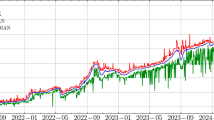Conclusions
Using tests for unit roots, serial correlation, and conditional heteroskedasticity, we find that the stochastic structure of the percentage changes in both the Franc/DM and Lira/DM rates is well described by a low order autoregression with ARCH disturbances. While this assertion is not rejected in either the Pre-EMS or the EMS period, we present evidence indicating a structural shift between sub-periods. In particular, while ARCH is present in each sub-period, its explicit parameterization changes dramatically.
Likelihood-ratio tests indicate the desirability of a bivariate analysis, and significant ARCH effects are found in the conditional variances and covariances over both subperiods. Likelihood ratio tests also indicate substantial structural change between the subperiods. The conditional variances of exchange rate innovations are used as natural measures of exchange rate volatility; it is found that volatility decreases substantially for both rates in the EMS period. Furthermore, the Franc shows a relatively greater volatility decrease with the move to the EMS, a result consistent with the narrower parity bands established for the Franc. Finally, the covariation of shocks to the two intra-EMS rates is shown to decrease between the Pre-EMS and EMS periods.
Similar content being viewed by others
References
Baba Y, Engle RF, Kraft D, Kroner K (1987) Multivariate simultaneous generalized ARCH. UCSD, Department of Economics manuscript
Bartlett MS (1966) An introduction to stochastic processes with special reference to methods and applications, second ed. Cambridge University Press, Cambridge
Bolterslev T (1986) Generalized ARCH. Journal of Econometrics 31:307–327
Bollerslev T (1987) A multivariate GARCH model with constant conditional correlations for a set of exchange rates. Manuscript, Northwestern University
Bollerslev T, Engle RF, Wooldridge JM (1988) A capital asset pricing model with time varying covariances. Journal of Political Economy 95:116–131
Booth P, Glassman D (1987) The statistical distribution of exchange rates. Journal of International Economics 22:297–319
Box GEP, Pierce DA (1970) Distribution of the residual autocorrelations in ARIMA time series models. Journal of the American Statistical Association 65:1509–1526
Dickey DA (1976) Hypothesis testing for nonstationary time series. PhD Dissertion, Iowa State University, Ames, Iowa
Diebold FX (1988) Empirical modeling of exchange rate dynamics. (Lecture Notes in Economics and Mathematical Systems, #303.) Springer-Verlag, New York Heidelberg Tokyo
Diebold FX, Nerlove M (1986) The dynamics of exchange rate volatility: a multivariate latent factor ARCH model. Special Studies Paper #205, Federal Reserve Board, forthcoming in Journal of Applied Econometrics
Diebold FX, Pauly P (1985) The time series properties of pre-EMS and EMS exchange rates with particular attention to volatility. Econometrics Discussion Paper Series, Dept. of Economics, University of Pennsylvania
Domowitz I, Hakkio CS (1984) Testing for serial correlation and common factor dynamics in the presence of heteroskedasticity. Northwestern University, Department of Economics, manuscript
Engle RF (1982) Autoregressive conditional heteroskedasticity with estimates of the variance of UK inflation. Econometrica 50:987–1008
Engle RF (1987) Multivariate GARCH with factor structures-cointegration in variance. UCSD, Department of Economics, manuscript
Engle RF, Bollerslev T (1986) Measuring the persistence in conditional variances. Econometric Reviews 5:1–50 (with discussion)
Fisher RA (1929) Tests of significance in harmonic analysis. Proc Roy Soc London, Ser A 125:54–59
Fuller WA (1976) Introduction to statistical time series. John Wiley and Sons, New York
Hasza DP, Fuller WA (1979) Estimation for autoregressive processes with unit roots. Annals of Statistics 7:1106–1120
Kraft D, Engle RF (1982) ARCH in multiple time-series models. UCSD Discussion Paper #82-23
Pantula SG (1985) Estimation of autoregressive models with ARCH errors. Manuscript, Department of Statistics, North Carolina State University
Said SE, Dickey DA (1984) Testing for unit roots in ARMA (p, q) models. Biometrika 71:599–607
Ungerer H, Evans O, Mayer T, Young P (1986) The european monetary system: recent developments. IMF Occasional Paper #48, Washington, DC
Weiss AA (1984) ARMA models with ARCH disturbances. Journal of Time Series Analysis 5:129–143
Westerfield JM (1977) An examination of foreign exchange risk under fixed and floating rate regimes. Journal of International Economics 7:181–200
Author information
Authors and Affiliations
Additional information
We would like to thank two anonymous referees for useful comments. The views expressed here are those of the authors and do not necessarily correspond to those of the Federal Reserve System or its staff.
Rights and permissions
About this article
Cite this article
Diebold, F.X., Pauly, P. Has the EMS reduced member-country exchange rate volatility?. Empirical Economics 13, 81–102 (1988). https://doi.org/10.1007/BF01973316
Received:
Revised:
Issue Date:
DOI: https://doi.org/10.1007/BF01973316




